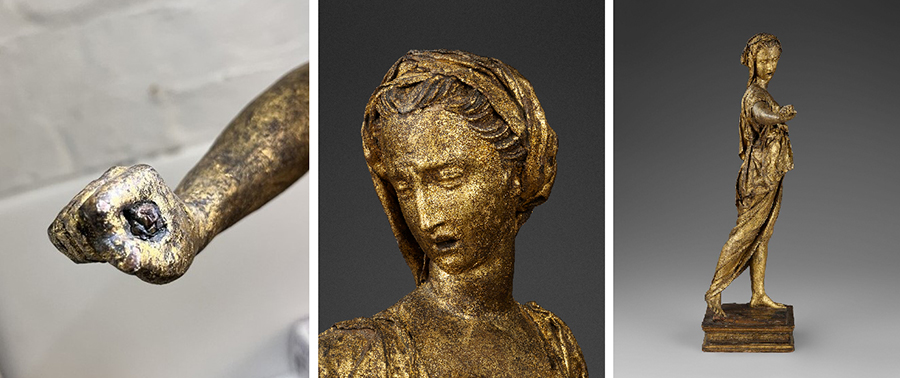Artistic Exploration through Sculpture
Examining a sculpture closely can unveil a treasure trove of insights into the artist’s creative methods. The gilded wooden statuette, Lucretia, crafted by the esteemed Italian sculptor and architect Jacopo Sansovino between 1508 and 1512, offers a glimpse into his heightened attention to detail and materials. This investigation into Lucretia has generated substantial academic interest by offering a fresh perspective on Sansovino’s artistic choices and techniques.
A Forgotten Marvel Rediscovered
When the statue was introduced to the V&A collection in 1962, it was initially misidentified as French and largely overlooked until further conservation efforts and analyses returned it to the spotlight in the 1980s. While Lucretia’s association with Sansovino began gaining traction over recent decades, recent advocacy from scholars like Lorenzo Principi and Bruce Boucher has solidified this attribution.
The Symbolism of Lucretia
Lucretia, a figure rooted in Roman legend, is dramatically depicted at the pivotal moment before taking her own life with a dagger. Although the blade is absent, her grip remains firm on the remnants of the hilt, while her poised limbs and facial expression encapsulate a profound narrative tension.
Material Composition and Technique
A thorough analysis carried out by V&A conservation scientist Jo Darrah revealed that the entire figure, including the base of Lucretia, was carved from a single piece of poplar wood. Interesting contrasts arise when compared with other known works by Sansovino, like Descent from the Cross and the Virgin and Child, which predominantly utilize wax and different fabrication techniques, showcasing his versatility in material application.
Innovative Fabrication Processes
Such experimentation in material choice indicates that Sansovino may have used these models as platforms to explore the deeper aspects of creating intricate, believable figures through an array of techniques.
Draping and Detailing Lucretia
Utilizing glue for Lucretia’s robe allowed Sansovino to achieve a dynamic representation of drapery. Upon first glance, the robe appears casually draped, but a closer inspection reveals careful arrangement, as each fold and contour serves to narrate Lucretia’s impending action. The robe’s delicate cling highlights her figure, especially at her thigh, amplifying the emotional complexity of the moment.
Holistic Representation of Motion
Sansovino’s attention to detail is not merely cosmetic; it extends to the very pose of the sculpture. After carving, adjustments in Lucretia’s head, neck, and right arm were made to dramatize her posture, emphasizing emotional intensity. An X-radiograph supports this, exhibiting adjustments made to ensure Lucretia’s gaze aligns with her action, enhancing the storytelling aspect of the piece.
The Nuances of Gesture
Particularly intriguing is how Lucretia’s left hand grips her robe. This subtle yet intentional choice highlights the moment’s gravity by suggesting she is about to reveal her heart. Upon deeper inspection, x-radiography discloses previous damage to the pointer finger that was repaired, underscoring Sansovino’s commitment to detail and realism.
The Evolution of Artistic Techniques
The intricate design of Lucretia stands as a testament to the intimate union of artistry and technology in the early 1500s. Each small-scale sculpture was not only an artistic endeavor but also served as a chance for Sansovino to push boundaries in both form and structure. This investigation raises essential questions about the purpose of these creations—were they merely artistic experiments or something more substantial?
Historical Context and Future Implications
The significance of pieces like Lucretia extends far beyond their immediate aesthetics. They represent pivotal moments in art history when innovation was synonymous with experimentation. As the world embraces various forms of art in tourism, understanding such masterpieces can enhance cultural experiences accessible through galleries, museums, and even travel itineraries.
It is vital that the art world continues to foster a dialogue on how works like Lucretia impact perceptions of craftsmanship and interpretation within the travels to regions steeped in rich artistic histories. Each insight derived from examining these works enriches global tourism experiences, promoting an appreciation for cultural artistry.
In closing, the significance of Jacopo Sansovino’s Lucretia lies not just in its beauty but also in its representation of artistic exploration and the historic shifts in sculpture techniques. Whether on beach holidays or lake escapes, the essence of craftsmanship can enhance experiences of sailing and yachting in regions where such art can be appreciated in person. Regardless of where adventure leads, GetBoat.com serves as an ideal marketplace for renting sailing boats and yachts tailored to every adventurer’s desires.


